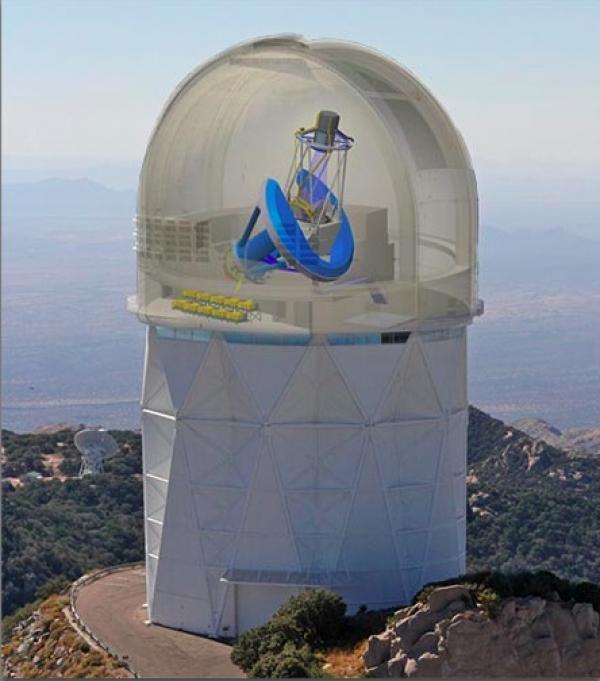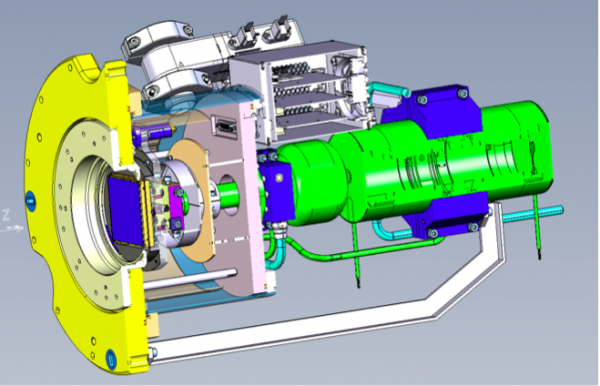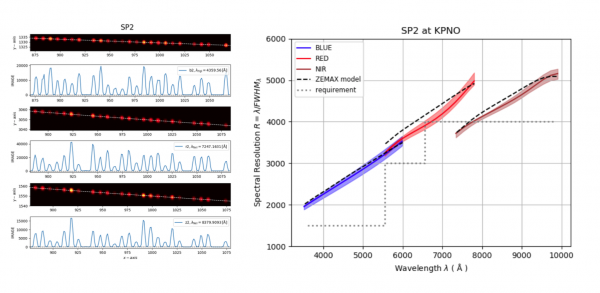
Figure 1: Installation of the cryostat of the red channel of the second spectrograph, on the site of the Mayall telescope. The cryostat contains an aligned CCD and is equipped with a pulsed tube that provides cooling at 140 K, stable at 0.1K. (credit: P.-H. Carton/Irfu).
The Dark Energy Spectroscopic Instrument (DESI) is intended to make the spectroscopic survey of 35 million galaxies and quasars from 2020 onwards, to study precisely the properties of dark energy. Its installation, started in 2018, has recently entered a new phase with the reception and assembly of the first two spectrographs out of the 10 that the instrument will include. Irfu, partner of the project since the beginning and responsible for the cryogenic part of the spectrographs, has successfully completed this installation. The next 8 spectrographs will be installed next May and September under the coordination of the Irfu team, in partnership with the local teams.
vidéo réalisée par Victor Silva (Irfu/DIS)
DESI, an ambitious project to decipher the enigma of the dark universe
DESI is being installed at the 4m Mayall Telescope (Fig. 2) located at the Kitt Peak National Observatory in Arizona. After the field corrector mounted in the summer of 2018, it is now the turn of the spectrographs to be installed on site. Eventually, 10 spectrographs will allow DESI to analyze the light of the objects pointed by the telescope, breaking it down into multiple wavelengths. The observation campaign, covering one third of the sky, will begin in 2020 and will last 5 years. It should produce at least 15 times more spectra than the two previous projects, BOSS (Baryon Oscillation Spectroscopic Survey) and eBOSS (extended Baryon Oscillation Spectroscopic Survey) now completed.
The accuracy of the measurements and the high number of astrophysical objects available from DESI - 5000 per exposure - will enable the mapping of visible matter with unprecedented accuracy, and this at several points in the past of the Universe, going back as far as 11 billion years ago. The distribution of visible matter at these different moments is the result of the way matter was structured in the first 400,000 years after the Big Bang, under the cross effect of gravity and the strong radiation pressure that prevailed then, but also of the evolution of this structuring during the later history of the Universe. DESI's observations will allow a better understanding of the accelerated expansion of the Universe and thus the properties of dark energy, but also the evolution of galaxies and dark matter, accessible through its gravitational effects.
DESI's observations have been prepared thanks to three image readings, now completed, which have made it possible to define the list and angular coordinates of the objects whose light DESI will analyze in order to trace their spectral shift, thus providing crucial information to study precisely the mapping of the matter of the Universe. Beyond its technical implications in the project, the Irfu team involved in DESI also plays a driving role in the methods and strategy of selecting the targets to be observed: very bright galaxies, bright red galaxies, emission line galaxies and quasars.

Figure 2: Artist's view showing the DESI instrument mounted on the Mayall 4-meter telescope at the Kitt Peak National Observatory in Arizona. The 10 spectrographs installed under the telescope (in yellow) will analyze the light of 5000 objects observable simultaneously at each exposure. DESI will study approximately 35 million galaxies and quasars to map the deepest Universe to date (credit: 2010 The Regents of the University of California, through the Lawrence Berkeley National Laboratory).

Figure 3: Partial sectional diagram of the final part of the cameras of the DESI spectrographs, designed at Irfu. The main elements of this assembly are a cryogenic enclosure carrying an input flange (in yellow) supporting the last lens of the spectrograph optics, a CCD (blue square) located just behind the lens and a thermal machine (in green) designed to cool the CCD. The cryogenic enclosure also carries the housing of the CCD reading electronics (in gray above the tube) as well as the connections to the pumping system (behind the housing). The alignment of the CCD in relation to the focal plane is ensured during the assembly phase of the cryostat with the Irfu (credit: P.-H. Carton/Irfu).
The cameras of the DESI spectrographs
DESI's spectrographs can observe 5000 objects simultaneously at each exposure on the sky. To accommodate DESI, the field of view of the Mayall telescope has been increased from 1 to 7 square degrees to accommodate 5000 robotic optical fibers on the focal plane of the instrument. At each exposure, the fibers are oriented in less than 2 minutes to point to new targets to be observed. These fibers lead the light to 10 spectrographs each formed of 3 channels, blue, red and near infrared (NIR) in order to cover the entire visible wavelength range. The 500 spectra obtained on each spectrograph are read by three cameras each consisting of a focusing optic and a CCD detector cooled in a cryogenic chamber (cryostat). The design of the spectrographs is the result of a collaboration between the Lawrence Berkeley National Laboratory (LNBL) in the United States, the French company Winlight Optics located in Pertuis, Vaucluse, Irfu and a group of CNRS laboratories in the Provence-Alpes-Côte d'Azur region.
Contributions of Irfu to the DESI instrument
Involved in the project from the beginning, Irfu is responsible for the design, assembly and control of the final part of the 30 cameras (field lens and detector assembly in their cryostat, Fig. 3), as well as the integration and precise positioning of the CCD detectors. Each cryostat has its own thermal machine, a pulsed tube designed at CEA Grenoble and marketed by the company Thales. The CCDs operate at a temperature of 140 K for the red and NIR channels and 163 K for the blue channels with a stability of 0.1 K. To maintain the vacuum at 10-7 mbar, very strict oven drying procedures have been implemented and an ion pump has been added to the vacuum chamber. The alignment of a CCD in a cryostat is a delicate operation due to the tolerances imposed by the optics: ±15 microns of parallelism with respect to the focal plane for a CCD of about 6x6 cm2. The mechanical assembly of the cryostats and the alignment of the CCDs are done in a clean room. Then, each camera is checked on a test bench (thermal, vacuum, alignment ...) and illuminations are made to characterize the detectors. The cameras are then sent to Winlight Optics, the company in charge of the spectrograph construction, for a complete characterization of the optical qualities of the spectrograph-camera chain by the CNRS teams.
The first 3 cameras were delivered to Winlight Optics and integrated into the first spectrograph by the Irfu team at the end of 2016 (see http://irfu.cea.fr/Phocea/Vie_des_labos/Ast/ast.php?t=fait_marquant&id_ast=3870). Since then, 18 cryostats with their CCD detector have been built and tested at Irfu, 15 of them have been optically mounted and tested on the first 5 spectrographs. Among these, two spectrographs and their 6 cameras were installed at the telescope in Kitt Peak earlier this year and are fully operational. A third spectrograph-camera assembly is on its way to the site. The completion of the construction, integration and installation of the spectrographs and cameras on the telescope is scheduled for the end of 2019.
Logbook of the Kitt Peak Installation
The installation of the first cryostats at the Mayall Telescope was carried out from January 28 to February 16 by a group of engineers and technicians from Irfu. The first week was devoted to setting up the cryostat control system, developed at DIS, the Irfu Systems Engineering Department, as well as the hundred or so cables needed for measurements, power supply and computer links. The control-command system consists of 3 electronic racks including a digital and PLC part, and interface drawers with the 30 cryostats. In parallel, the members of the DEDIP, the Department of Sensor Electronics and Computing for Irfu Physics mounted 2 pumping groups and installed the cooling circuit of the thermal machines to prepare the operation of the cryostats.
During the second week, all the functional tests of the system were carried out, including the very important remote control of the cryostats (vacuum control and cold lowering) via a secure external link. This week was also devoted to the training of the local telescope team in the handling of the system, which it will have to ensure the operation of the system during the 5 years of observation of the DESI instrument.
Finally, during the third week, the Irfu, telescope and LBNL teams proceeded to the actual installation of the first 2 spectrographs and their associated cryostats (Fig. 1). At the end of the mission, the two spectrographs and their 6 cryostats were in nominal operational conditions, allowing the next phase of the optical tests. These tests, carried out since then by the LBNL and CNRS teams, demonstrated excellent optical performances, in accordance with the required specifications (Fig. 4). This result validates the thermo-mechanical design of the cryostats and the CCD positioning procedures implemented by Irfu.
Contacts: Pierre-Henri Carton (Dedip), Christophe Magneville (DPhP), Vanina Ruhlmann-Kleider (DPhP)

Figure 4: Spectral resolution of the second spectrograph installed at the Mayall telescope, measured in situ. On the left, images of light spots of different intensities (blue curves) delivered by test optical fibers placed at the entrance of the three channels of the spectrograph. On the right, resolutions measured for the three channels (in blue, red and brown). The resolutions are better than the specifications (dotted lines) and in accordance with the optical model of the instrument (dashes) (credit: Julien Guy/LBNL).
• Structure and evolution of the Universe › Dark Universe
• Institute of Research into the Fundamental Laws of the Universe • The Electronics, Detectors and Computing Division • The Particle Physics Division • The Systems Engineering Division
• Laboratory of Mechanical Studies and Detectors Integration (LEMID) • Cosmology • Electrical Engineering Studies and Integration Laboratory (LEIGE) • Laboratory of Development and Integration of Control System (LDISC)
• BAO
